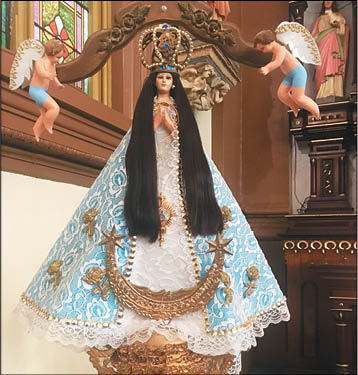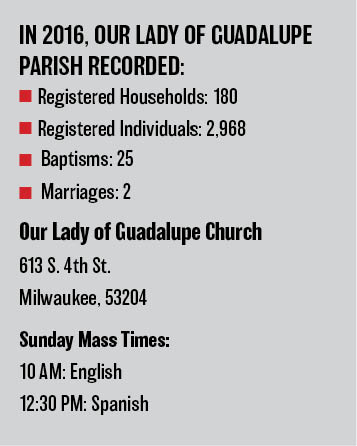Our Lady of Guadalupe in Milwaukee
When you ask Jesuit Fr. Timothy Manatt, pastor of Our Lady of Guadalupe Church, what he would want visitors and guests to know about this historic parish, he is quick to point out the parish’s rich and varied history as a home for immigrants. “To the theme of the United States as a country of immigrants, it always has been and is today, a parish that welcomes immigrants and is made up of immigrants.” 
With distinction of being the third Catholic church in the city and second oldest Catholic church still in use, Our Lady of Guadalupe’s worship space has, in fact, shared in the richness of the variety of languages and cultures that have shaped the Walker’s Point neighborhood for more than 150 years.
The historic church — first known as Holy Trinity — was founded in 1849 by Fr. Joseph Salzmann, a German immigrant, to serve the growing German-speaking Catholic community in the newly established Walker’s Point neighborhood. The church was dedicated on Sept. 22, 1850, by then-Bishop John Martin Henni. Donations for the new church were sent from Europe by the Leopolinen Stiftung of Vienna and the Ludwig Missions Verein of Munich, including a generous gift from Vincent Edward, the Prince-Archbishop of Vienna. The parish was able to open a new school that same year, staffed by the School Sisters of Notre Dame.
The succeeding years would see a number of improvements to the building, including the addition of stained glass windows, greater ornamentation on the altars, the installation of a large pipe organ, and the donation of a new pulpit by the St. Joseph Young Men’s Society.
In a 1925 book celebrating the 75th anniversary of the parish, an unnamed author honored the founding generation in these words: “The men and women who founded Holy Trinity Parish seventy-five years ago, have all passed to their eternal reward. Generation upon generation has succeeded them. Each has made its contribution in service and prayer.”
Even as Holy Trinity Parish was celebrating that special anniversary, a new community of faith was coming together in Walker’s Point as Jesuit Fr. Luis Fusz, pastor of Milwaukee’s Gésu Church, began a ministry to Mexican immigrants. These workers had come to Milwaukee to take jobs with the Pfister and Vogel Leather Company and the Illinois Steel Company.
Missions were preached and Fr. William Haberstock, Holy Trinity’s pastor, provided space in the school hall for Mass and other services until a more permanent solution could be found. The archdiocese eventually purchased the former Duro Soap Company building. Archbishop Sebastian Messmer dedicated the storefront church on Dec. 12, 1926. The mission was named for the Blessed Virgin Mary, under her title “Our Lady of Guadalupe.” The mission’s first pastor, Fr. Ernesto Orsorio Aguirre, a priest of the Order of Our Lady of Mercy, had assumed his duties on July 1, 1926. The Mercedarian Fathers would provide pastoral care for the mission until 1946. Gabriela Pérez de Gutiérrez, who was the first child baptized at the mission on Aug. 8, 1926, is still living and remains an active presence at Our Lady of Guadalupe. In 1944, the community moved to a new storefront church, previously the home of the Hanover Telephone Exchange, and the mission was finally given full status as a parish in 1946.
In those years, as Fr. Haberstock was helping provide pastoral care for the growing Mexican community, he also saw that the Slovak population at Holy Trinity was eclipsing the original German-speaking community. In response, he invited Fr. Victor Ragulj, a Conventual Franciscan, to share in the pastoral responsibilities. Fr. Victor became pastor of Holy Trinity when Fr. Haberstock retired in 1937. The Conventual Franciscans would continue to provide pastoral care of the community until 1986, at which time the Archdiocese of Milwaukee resumed administration of the parish.

Statue of the “Virgin of San Juan de los Lagos” in Our Lady of Guadalupe Church
The late 1940s and 1950s saw an increase of settlers from Puerto Rico and various parts of Latin and South America, and the community at Our Lady of Guadalupe continued to grow, even as the historic parish community at Holy Trinity diminished. To meet the needs of the two communities, Archbishop William E. Cousins made an historic decision to merge the parishes, forming what was known as Holy Trinity-Our Lady of Guadalupe Parish. To mark the official merger of the two communities, parishioners carrying a banner with the image of La Morenita processed from Our Lady of Guadalupe to Holy Trinity on Aug. 28, 1966.
In the decades since, the parish, now simply known as Our Lady of Guadalupe, has continued to provide pastoral care for a diversity of parishioners from Mexico, Puerto Rico, and other parts of Latin and South America. Bertha Rodriguez, a lifelong parishioner, continues to make the parish her home “because of the history it has in our community and in our family.” Recalling when her family arrived in Walker’s Point 42 years ago, she said, “I think the parish made them feel welcomed and it was a place where they felt that they could continue their practice as they did in Mexico. We have been baptized, made our First Communion, confirmation, and some have had their weddings there. My siblings and I continued the same tradition with our own children.”
Remarking on the gift that Our Lady of Guadalupe Church provides for the Walker’s Point neighborhood, Rodriguez said that the Virgin of Guadalupe is a “matron” of Mexican culture. “The annual celebration in December that we have for her brings so many people back from the community to the parish.” For her, and for many others, “Guadalupe” remains home. 
In 2006, Jesuit Fr. José Moreno, pastor of nearby St. Patrick’s, became pastor of Our Lady of Guadalupe, marking a new era in the parish’s history, as the Society of Jesus began providing pastoral care for both parishes. Fr. Manatt, the current pastor, believes the Jesuit tradition offers a wonderful gift for the community. “At least four times a year I will lead the congregation in Ignatian meditation and imagine the Gospel unfolding in their minds,” Fr. Manatt said. “I hope they have a better sense of themselves as loved sinners and someone who is in close relationship with Jesus Christ.”
To support this spiritual bond with Christ and the Church, Fr. Manatt, whose 21 years of Jesuit life have been divided between ministry in the Native- and Mexican-American communities, actively supports parishioners through home visits and family and marriage outreach. Ultimately, Fr. Manatt recognizes the parish as a place of gathering and encounter. “We want to be as welcoming a place for worship as we can be. On a nice day, you will easily see 40 or 50 people lingering in front of the church.” While the parish now shares catechetical and faith formation programs with nearby St. Patrick’s, Our Lady of Guadalupe remains a strong presence and the community continues to look for ways to reach out to its ever-changing Walker’s
Point neighborhood.
